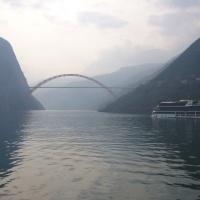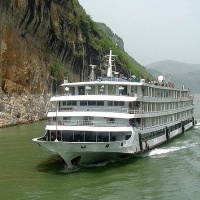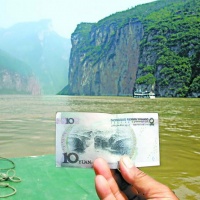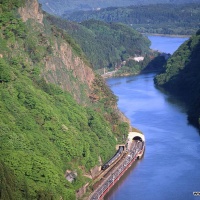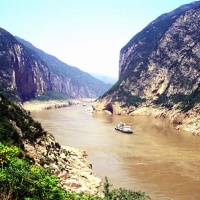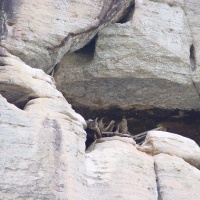- Home Page
- Fact Tours
Our sample tour itineraries of China and China travel packages are sorted by theme and available at competitive prices, you can browse what tours are right for you for your trip to China.
Popular China Tour Packages

Custom Tour Packages to China and Ask Our Experts for Free Enquiry !
- Coach Tours
- Destinations
Beijing, the capital of China. Its art treasures and universities have long made it a center of culture and art in China.
Beijing Top Attractions
Beijing City Tours
Best China Tours with Beijing
Shanghai, the cultural and economic center of East Asia. It renowned for its historical landmarks, the extensive and growing skyline.
Shanghai Top Attractions
Shanghai City Tours
Best China Tours with Shanghai
Xi'an, having held the position under several of the most important dynasties. It is the top destination to explore the facts of Chinese history.
Xi'an Top Attractions
Xi'an City Tours
Best China Tours with Xi'an
Huangshan boasts its culture, beautiful rivers, villages and mountains. It's home to 2 UNESCO World Heritage Sites and the Mecca of photographers.
Huangshan Top Attractions
Huangshan City Tours
Best China Tours with Huangshan
Sichuan is the cradle of the Shu culture, panda, mahjong, teahouse and spicy food. The province ranks first in China by number of UNESCO World Heritage Sites. It is called "the Heaven of Abundance".
Sichuan Top Attractions
Sichuan Tour Packages
Best China Tours with Sichuan
Yunnan, literally means the south of colorful clouds, due to its beautiful landscapes, mild climate and diverse ethnic cultures and traditions, is one of China's major tourist destinations.
Yunnan Top Attractions
Tibet, the nearest land to the sky, is known for its breathtaking landscape, splendid culture, art, buildings, and mysterious religions.
Tibet Top Attractions
Tibet Tour Packages
Best China Tours with Tibet
Explore the lost civilizations by riding a camel! Travel across the Gobi and the desert, and over the high mountains. Our Silk Road tours including different sections of the Silk Road in China.
Silk Road Top Attractions
Silk Road Tour Packages
Best China Tours with Silk Road
Guilin, an internationally-known historical and cultural city, has long been renowned for its unique karst scenery. Its vicinities are the paradise of hiking, caving, rafting, biking and countryside exploring.
Guilin Top Attractions
- China Facts
- China Hotels
- Travel Photos
Three Gorges
The Three Gorges of the Yangtze River, a world-renowned tourist attraction, start at Baidicheng (White Emperor City) in Fengjie County in the west and east at Nanjingguan Pass (Southern Crossing) in Yichang to the east, passing through Badong, Zigui counties and Yichang City in Huber Province. The total length of the gorges extends 193 kilometers. Except the Daning River valley and the Xiangxi (Fragrant Stream) Valley, the gorges themselves are 93 kilometers long. The first gorge of the three from west to east, known as Qutang Gorge, is 7 kilometers, Wu Gorge, the second one, runs west to east for 44 kilometers; Xiling Gorge, the last of the three, extends a distance of 42 kilometers.
The steep mountains, the dangerous rugged shoals and the turbulent waters are characteristic of the gorges. The perpendicular cliff and grotesque peaks with clouds wrapping them in a blanket of mist create one of nature's most majestic sights.
Perfect tours to the Three Gorges>> 4-Day Yangtze Cruise Tour 11-Day Magnificent China
The Three Gorges themselves are a long poem, a mysterious natural gallery. Qutang Gorge is famous for the ancient coffins placed on the cliffs and its magnificent precipices, the latter which form a colossal, nearly perfect gate over the river. Wu Gorge, with soaring fascinating mountain peaks rising from the riverbanks, is severe and secluded, and presents a panorama of lovely scenery. Xiling Gorge is noted for its numerous hidden rocks and perilous shoals. The stunning scenery along the gorges, which never fails to appeal to visitors, will surely make them admire the mysterious creative power of nature.
Qutang Gorge
Originating on the Oinghai Highland, the 6,300 –kilometer-long Yangtze River, the longest river in China, sweeps east. When the river reaches eastern Sichuan, it cuts through the Wushan Mountain, there the river course suddenly narrows and the waters become turbulent. Craggy mountains rise on either side, creating the Three Gorges- reputed as one of China's greatest natural wonders. The first gorge is named Qutang Gorge (Qutangxia), which extends from Baidicheng in the west to the town of Daqizhen in the east. With precipices towering over the two banks only 100meters apart, the mighty Yangtze River waters are suddenly constricted in front of Kuimen Gate, the gorge entrance. Waves billow, currents whirl and the river roar angrily. Sailing through the 7-kilometer-long Qutang Gorge, the tourist occasionally sees narrow paths carved on the riverside cliffs. In ancient times these were the only roads for troop movements, mercantile transport and boat towing. The boat haulers, prostrating themselves almost to the ground, would plod on and on while singing sad "work songs" to synchronize their movements. If any of them dropped from illness or exhaustion, the boat owner, however hind-hearted he might be, could not steer to the shore to pick him up. He had to be left to his fate on the towpath. It is the shortest, but the most magnificent of the Three Gorges. It is also known as the most fearsome waterway.
Qutang Gorge is also known as Kui Gorge (Kuixia). It controls the flow of the Yangtze River and is the gateway between Chongqing Municipality and Hubei Province.
Wu Gorge
Wuxia Gorge (Wuxia) stretches across Chongqing Municipality and Hubei Province, from the Daning River Estuary in Sichuan to the Guandukou in Baidong County of Huibei Province in the east.
Flanked by the craggy peaks and grotesque rock, it forms a meandering scenic gallery, totaling 44kilometers in distance. Sometimes there seems no way ahead, suddenly an unimpeded path is in front while the water winds along mountain ridges. The beautiful scenery on both banks is too capricious to take them all in.
On a cruise down the Wu Gorge, the tourist’s mind is on twelve peaks Six of the 12 sentinel peaks line the north bank: the Shengquan (Sage Spring), Jixian (congregated Immortals), Songluan (Fir Tree Cone), Shennu (Goddess), Zhaoyun (Facing Clouds) and Denglong (Climbing Dragon).Of the other six peaks on the south bank, there are visible: Juhe (Assemble Crain), Cuiping (Misty Screen) and Feifeng (Flying Phoenix). The other three of Qingtan (Clean Altar), Qiyun (Rising Cloud) and Shangsheng (Mounting Aloft) are hidden behind the peaks on the right of Qingqi Stream, tributary of Yangtze River. That is why great poet Lu You (1125-1210) of southern Song Dynasty wrote: "Nine out of twelve mountain peaks are visible." All the peaks are given their names by their different shapes. Varying from seasons and weathers, their pretty scenery is the everlasting appeal to tourists.
The Daning River, a 300-kilometer-long tributary joins the Yangtze River at the mouth of the Wu Gorge. It is full of shoals and whirling pools. With precipitous peaks standing on two sides and turbulent currents smashing against rock-sides, the scenery there is just like a landscape painting, and in many ways like those of the Yangtze Gorge, hence the name “the Three Little Gorge.”
Xiling Gorge
Xiling Gorge (Xilingxia) begins at the Xiangxi (Fragrant Stream) in the west and ends at Nanjingguan Pass in the east. It is known for its numerous hidden rocks, dangerous shoals and turbulent rapids. Xiling Gorge consists of 4 small gorges and several dangerous shoals; the Gorge of the Sword and Book on the Art of War, the Gorge of the Shadow Play; The Blue Shoal, the Discharge Shoal, the Kongling Shoal and the Yaocha Shoal. Since the Gezhou Dam Project was completed, the turbulent has been smoothed down while the scenery along the gorges remains intact.
It is said that the Gorge of the Sword and the Book on the Art of War was the place where Zhuge Liang (a statement and strategist in the Three kingdoms period (220-280), who became a symbol of resourcefulness and wisdom in Chinese folklore), Prime Minister of Shu state of the Three Kingdoms period, had stored his grain and a book on the art of war. The Gorges of the Cow Liver and the Horse's Lung is on the north bank of the Yangtze River. On the cliff there are 4 0r 5 yellow stone slabs shaped like cow’s livers. Above them visitors can see half of a rock there in the form of a horse‘s lung. The Kongling Gorge used to be full of hidden rocks, which results in rapids. On the riverbank of Kongling Gorge stands a set of rocks, which looks like a person leading a cow. This small section is called the Cow Gorge with the person colored black and the cow colored yellow. The Shadow Play Gorge is situated on the south bank of the Yangtze River. The four rocks jutting up into the sky resemble four characters in the Chinese mythological novel "Pilgrimage to the West". When viewed from a distance, Monkey Pigsty, Sandy and the Buddhist Monk silhouetted against the setting sun are really in a nature shadow play, hence the name.
Crashing through narrow Nanjingguan (Southern Crossing) Pass, the eastern gorge exist, the river suddenly widens to approximately 2,000meters and a vast plain comes into view, Passengers will flock to the sides of the boat to see Gezhouba (Gezhou Dam), the first dam built on the Yangtze River. The project, completed in 1981, was China's largest hydropower installation. Tourists will admire the mammoth structure and watch the streamer enter the ship lock, lowering it scores of meters and then sailing on.
Questions & Comments
Copyright © 2008-2010 China Fact Tours. All rights reserved










